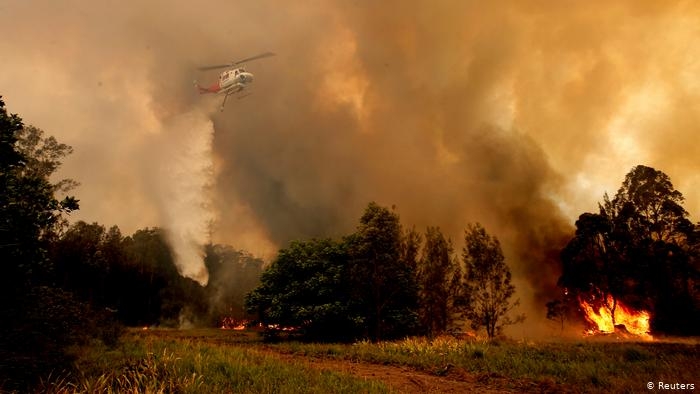Bushfire state of emergency declared in Australia

Australian authorities declared a seven-day state of emergency in New South Wales state as a record heat wave fanned unprecedented bushfires raging across the region.
Some 100 fires have been burning for weeks in the state, with half of those uncontained, including a “mega-blaze” ringing Sydney, covering Australia’s biggest city in a haze of toxic smoke.
NSW Premier Gladys Berejiklian said the state of emergency, the second declared in the state since an early, drought-fuelled bushfire season began in September, was due to “catastrophic weather conditions.”
The country experienced its hottest day on record Tuesday, with the average nationwide temperatures reaching 40.9 degrees Celsius, which is expected to be surpassed as an intensifying heat wave spreads across the east.
Temperatures are expected to peak at 41 degrees Celsius in central Sydney and 45 degrees Celsius in the western suburbs today, while turbulent winds of up to 100 kilometres in the afternoon expected to fan bushfires burning ever-closer to the city.
There are 2,000 firefighters battling the blazes with the support of US and Canadian teams, as well as Australia Defence Force personnel.
New South Wales Rural Fire Service commissioner Shane Fitzsimmons said five 100-person “strike teams” were on standby to deploy to the most dangerous fires, “given the enormity of some of these fire complexities and the severity of the forecast weather conditions that are expected to unfold throughout today.”
“The worst of the fire weather conditions, the extreme fire danger ratings we are expecting today, are centred around the greater Sydney environment,” he added.
The extreme weather is also causing major health concerns, with leading doctors this week labelling the smoke haze that has shrouded Sydney for weeks a “public health emergency.”
Hospitals have been recording large increases in emergency room visits for respiratory problems, including a dramatic 80 percent spike when air quality plummeted on December 10.
More than 70 fires are also raging across Queensland state to the north of NSW, including one at Peregian, near the coastal tourist hub of Noosa, that forced people to flee their homes Wednesday. Bushfires are also burning in South Australia and Western Australia.
At least three million hectares of land has been torched across Australia in recent months, with six people killed and more than 800 homes destroyed.
Scientists say the blazes have come earlier and with more intensity than usual due to global warming and a prolonged drought that has left the land tinder dry and many towns running out of water.
The fires have sparked climate protests targeting the conservative government, which has resisted pressure to address the root causes of global warming in order to protect the country’s lucrative coal export industry.
Climate protesters plan to march on Prime Minister Scott Morrison’s official residence in Sydney to demand curbs on greenhouse gas emissions and highlight his absence on an overseas holiday as large parts of the country burn.
